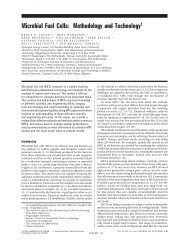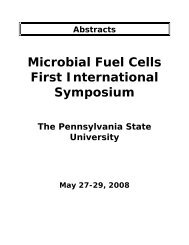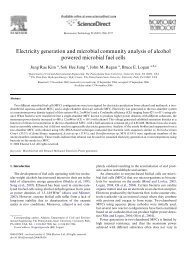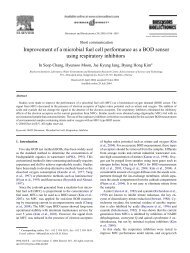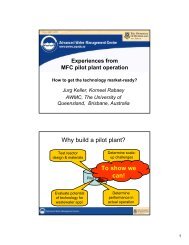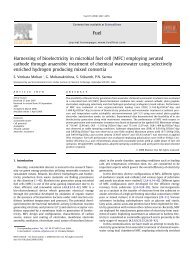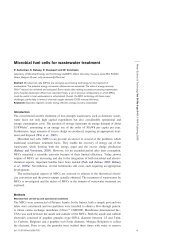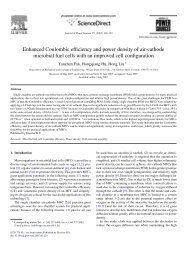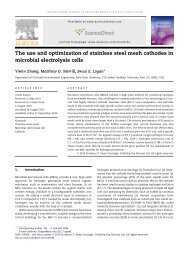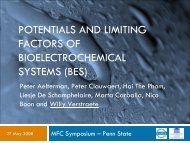Bioelectrochemical systems for wastewater treatment
Bioelectrochemical systems for wastewater treatment
Bioelectrochemical systems for wastewater treatment
Create successful ePaper yourself
Turn your PDF publications into a flip-book with our unique Google optimized e-Paper software.
<strong>Bioelectrochemical</strong><br />
<strong>wastewater</strong> <strong>treatment</strong>:<br />
not so elementary<br />
René Rozendal,<br />
Bert Hamelers<br />
Cees Buisman<br />
Korneel Rabaey<br />
Jurg Keller<br />
MFCs First International symposium, 29 May 2008, Penn State
<strong>Bioelectrochemical</strong> <strong>systems</strong><br />
• Exponential increase<br />
over the years<br />
• Currents approach levels<br />
suitable <strong>for</strong> practical<br />
implementation<br />
– ~10 A/m 2
<strong>Bioelectrochemical</strong> <strong>wastewater</strong><br />
<strong>treatment</strong><br />
• 1000 A/m 3<br />
– 10 A/m 2<br />
– Cell thickness 1 cm<br />
• ~7 kg COD/m 3 /day<br />
– Aerobic: 0.5‐2 kg COD/m 3 /day<br />
– Anaerobic: 8‐20 kg COD/m 3 /day<br />
•BUT…
Reality check<br />
• Size matters!<br />
– Smaller better than larger<br />
• Real <strong>wastewater</strong>s?!<br />
– Synthetic media outper<strong>for</strong>m real WW
Why not implemented already?<br />
• Microbiological challenges<br />
• Technological challenges<br />
• Economic challenges<br />
Rozendal et al. (2008), Trends Biotechnol., In press
Microbiological challenges<br />
• Complex matter<br />
– Polymers/particulates<br />
– More experience required<br />
• Methanogenesis<br />
• Biofilm gradients
Biofilm gradients<br />
(Concentration polarization)<br />
[Reactants]<br />
[Products]<br />
pH!!!
Why not implement already?<br />
• Microbiological challenges<br />
• Technological challenges<br />
• Economic challenges
Technological challenges<br />
• Ohmic losses<br />
• Membrane pH gradients
Rozendal et al. (2008), Trends Biotechnol., In press<br />
Real<br />
Laboratory<br />
Keep the electrode spacing as small as possible!!!
Ohmic loss across the electrodes<br />
Single cell design<br />
= Travel distance electrons<br />
= Travel distance ions<br />
Rozendal et al. (2008), Trends Biotechnol., In press
Ohmic losses<br />
GRAPHITE<br />
• Resistivity of material: 10 mΩ cm<br />
• 10 A/m 2 (assume on average half of this passes true the plane of the electrode)<br />
Laboratory scale (10×10×0.3 cm):<br />
L<br />
10cm<br />
R = ρ = 10mΩ<br />
cm = 33mΩ<br />
A<br />
3cm2<br />
I=10 A/m 2 ×0.01=0.1 A ΔV = 0.033×0.1×0.5=0.0017 V<br />
Large scale (100×100×0.3 cm):<br />
L<br />
100cm<br />
R = ρ = 10mΩ<br />
cm = 33mΩ<br />
A<br />
30cm2<br />
I=10 A/m 2 ×1=10 A ΔV = 0.033×10×0.5=0.17 V
Technological challenges<br />
• Ohmic losses<br />
• Membrane pH gradients
Cation Exchange Membranes<br />
• Wastewater:<br />
– pH 7 [H + ] = 10 ‐4 mM<br />
– [Na + ], [K + ], [NH 4+ ] ≈ 10 mM<br />
×100000!!!<br />
• Not much protons available to transport!!!<br />
• Other cations also transported!<br />
Rozendal et al. (2006), Environ. Sci. Technol. 40, 5206-5211
Membrane Ion Transport<br />
Ideal:<br />
H +<br />
H +<br />
H +<br />
pH<br />
Practice:<br />
Per<strong>for</strong>mance<br />
Na +<br />
K +<br />
NH 4<br />
+
Per<strong>for</strong>mance loss
Per<strong>for</strong>mance loss due to pH effects!<br />
Rozendal et al. (2006), Environ. Sci. Technol. 40, 5206-5211
Alternative Types of Membranes<br />
Rozendal et al. (2008), Water Sci. Technol. Accepted
Why not implement already?<br />
• Microbiological challenges<br />
• Technological challenges<br />
• Economic challenges
Case (1000 A/m 3 )<br />
• Laboratory materials (lifetime 5 year)<br />
– Anode: 100 €/m 2 (graphite felt)<br />
– Membrane: 400 €/m 2 (Nafion)<br />
– Cathode: 500 €/m 2 (Pt catalyzed)<br />
– Collector: 25 €/m 2<br />
• Other cost (lifetime 25 years)<br />
– Reactor: 4000 €/m3<br />
– Rest: 1000 €/m3
Rozendal et al. (2008), Trends Biotechnol., In press<br />
Capital costs<br />
TOO<br />
EXPENSIVE!!!<br />
For comparison: Anaerobic Digestion ~0.01-0.05 €/kg COD
Case (1000 A/m 3 )<br />
• Future materials (lifetime 5 year)<br />
– Anode: 100 5 €/m 2 (graphite paper)<br />
– Membrane: 400 10 €/m 2 (CEM)<br />
– Cathode: 500 5 €/m 2 (biocathode)<br />
– Collector: 25 10 €/m 2<br />
• Other cost (lifetime 25 years)<br />
– Reactor: 4000 €/m3<br />
– Rest: 1000 €/m3
Rozendal et al. (2008), Trends Biotechnol., In press<br />
Capital costs<br />
For comparison: Anaerobic Digestion ~0.01-0.05 €/kg COD
System<br />
Product<br />
Revenue<br />
Capital<br />
costs<br />
(€/kg COD)<br />
Product<br />
revenue<br />
(€/kg COD)<br />
Offset<br />
(€/kg COD)<br />
Aerobic - -0.1 -0.2 -0.3<br />
AD CH 4 0.05 0.1 0.05<br />
MFC Electricity 0.4 0.2 0.2<br />
MEC H 2 0.4 0.6 0.2<br />
MEC ??? 0.4 $$$ $$$
Conclusion<br />
• <strong>Bioelectrochemical</strong> <strong>wastewater</strong><br />
<strong>treatment</strong> promising, but…<br />
– Microbiological,…<br />
– Technological, and…<br />
– Economic challenges!<br />
• Much to gain beyond electricity<br />
– Biocathodes (See: Korneel Rabaey)
ACKNOWLEDGEMENTS<br />
Thank you!



